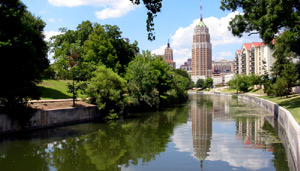About San Antonio
our host city

Native American Indians originally lived along the San Antonio River in the San Pedro Springs area, calling the vicinity Yanaguana, meaning "refreshing waters." In 1691, a group of Spanish explorers and missionaries came upon the river on the feast day of St. Anthony, hence naming the river after "San Antonio."
The actual founding of the city took place in 1718 by Father Antonio Olivares, upon establishing Mission San Antonio de Valero. The efforts of Spanish soldiers and Canary Islanders, San Antonio soon transformed into an early Spanish settlement in the Americas.

The Battle of the Alamo took place nearby in 1836, and eventually the town would grow to encompass the embattled mission. This was where 189 defenders held the old mission against some 4,000 Mexican troops for 13 days. The cry "Remember the Alamo" became the rallying point of the Texan revolution against Mexico.
Today, the Alamo is a shrine and museum located in the heart of downtown, and is surrounded by many hotels and tourist attractions. It is clearly San Antonio's most well-known landmark, and is featured in its flag and seal and in the city's nickname, "Alamo City".
Famous for its River Walk, the Alamo, Tejano culture, and being home to SeaWorld and Six Flags Fiesta Texas theme parks, the city is visited by 20 million tourists per year. San Antonio is also home to the first museum of Modern Art in Texas�the Marion Koogler McNay Art Museum.

The River Walk (pictured to the left) was the idea of architect Robert Hugman in the late 1920s. As an alternative to paving over the troublesome San Antonio River, Hugman drew out a plan he called "The Shops of Aragon and Romula" which allowed for both flood prevention and commercial development. Hugman maintained his office along the shallow river, despite warnings that he would be "drowned like a rat" and its early reputation as a dangerous hole. Hugman persisted, and his office can still be found next door to another early presence on the River Walk, the landmark Casa Rio restaurant.
Without a doubt, San Antonio is a diverse, historic, and fascinating city, and will offer many opportunities for visiting SCI composers and performers to engage in musical discussions, relaxation, and sightseeing. More information can be found at The San Antonio Chamber of Commerce, The Visitor's Bureau, and many sites online. Take this opportunity to explore this wonderful city during our 2006 conference!
This information is adapted from wikipedia and several other sources
Directions
- Airport to Hotel
- Hotel to UTSA
- Hotel to Trinity
- Hotel to Incarnate Word
- Hotel to Travis Park UMC
- Hotel to Banquet